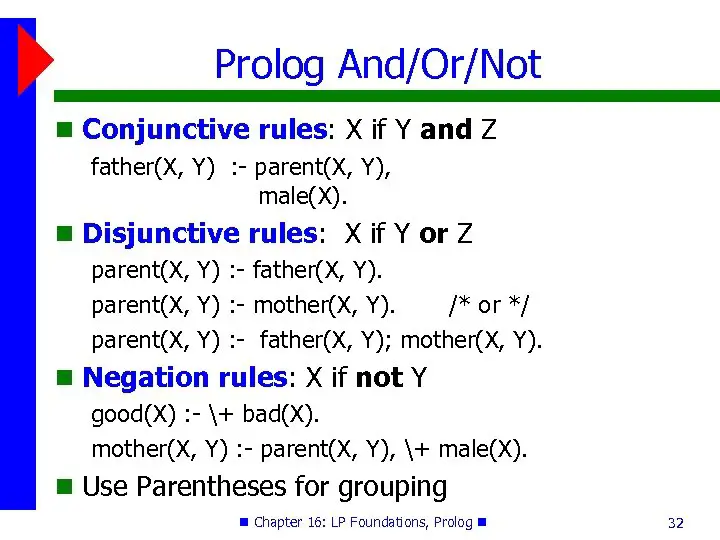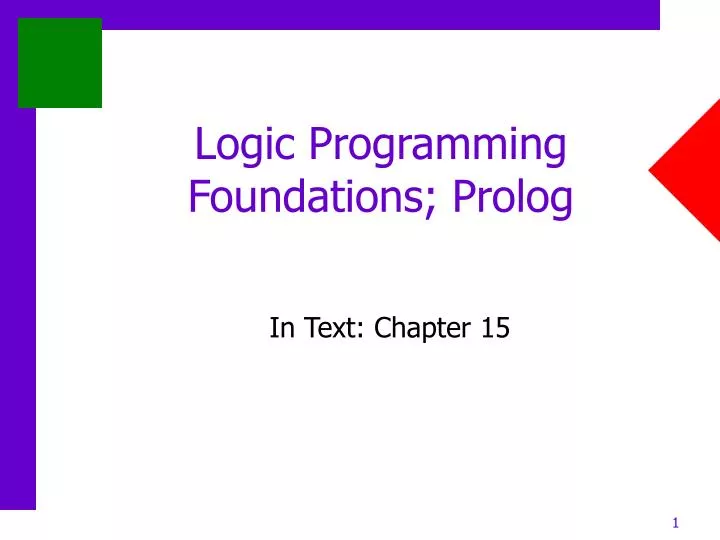Foundations of Prolog

Prolog (Programming in Logic) is a high-level logic programming language developed in the 1970s at the University of Edinburgh, primarily by Alain Colmerauer, Robert Kowalski, and David Warren. It is based on the concept of using logical rules to represent knowledge and solve problems.

Key Principles of Prolog:

- Declarative Programming: Prolog programs consist of facts (statements that are true) and rules (conditional statements). This focus on declaratively expressing problems distinguishes Prolog from imperative languages.
- Horn Clauses: Prolog rules are expressed in the form of Horn clauses, which are logical implications where one or more premises (if) lead to a conclusion (then).
- Unification: Prolog uses unification, a process of matching patterns between expressions, to evaluate rules and derive new facts.
- Recursion: Prolog allows for recursive definitions, enabling the expression of complex relationships and problem-solving techniques.
- Backtracking: Prolog uses backtracking to explore different paths of reasoning and find all possible solutions.
Continuing Legacy of Prolog
Prolog has had a significant impact on computer science and artificial intelligence:
- Symbolic Reasoning: Prolog enabled symbolic reasoning, allowing computers to handle abstract concepts and knowledge representation.
- Natural Language Processing: Prolog’s logical structure proved useful for developing natural language processing systems.
- Expert Systems: Prolog became a popular tool for creating expert systems, which mimic human expertise in solving complex problems.
- Databases: Prolog’s declarative approach made it suitable for querying and manipulating databases.
- Education: Prolog’s simplicity and focus on logical reasoning make it an excellent teaching tool for logic programming and artificial intelligence concepts.
Current Applications of Prolog
While Prolog’s popularity has waned in some areas, it continues to be used in various domains:
- Constraint Logic Programming: Prolog forms the basis for constraint logic programming (CLP), which combines logical reasoning with constraints, enabling the modeling and solving of complex problems.
- Natural Language Understanding: Prolog is still employed in some natural language understanding systems for semantic analysis and question answering.
- Deductive Databases: Prolog’s logical foundations make it suitable for deductive databases, allowing for declarative querying and inferencing.
- Education: Prolog remains a useful educational tool for teaching logic programming, artificial intelligence, and problem-solving.
- Specialized Domains: Prolog continues to be used in niche domains, such as legal reasoning, medical diagnosis, and knowledge management.
Conclusion
The foundations of Prolog as a declarative logic programming language have laid the groundwork for advanced reasoning techniques. Despite its declining popularity for general-purpose programming, Prolog continues to have a strong legacy and is still used in specialized domains and educational settings. Its logical approach and symbolic reasoning capabilities remain valuable for solving complex problems in artificial intelligence and knowledge representation.## The Foundations Of Prolog And Its Continuing Legacy
Executive Summary
Prolog, short for PROgramming in LOGic, is a declarative programming language that has had a profound impact on artificial intelligence and the field of computer science. Since its inception in the mid-1970s, Prolog has served as a cornerstone for groundbreaking developments in expert systems, natural language processing, and knowledge representation. In this comprehensive article, we delve into the foundations of Prolog and explore its enduring legacy in shaping the modern technological landscape.
Introduction
Prolog was conceived in the early 1970s at the University of Edinburgh by a group of researchers led by Alan Colmerauer. Its unique approach to programming, based on logical rules and relationships rather than explicit instructions, set it apart from conventional imperative languages. As a pioneer in logic programming, Prolog has paved the way for a new paradigm in software development, emphasizing declarative programming and problem-solving through symbolic reasoning.
FAQs
-
Q: What is the key characteristic of Prolog?
- A: Prolog is a declarative language that focuses on representing knowledge and rules, allowing the computer to infer conclusions based on these logical constructs.
-
Q: What are the primary applications of Prolog?
- A: Prolog has been extensively used in artificial intelligence, expert systems, natural language processing, and knowledge representation.
-
Q: Is Prolog still relevant in the modern era of computing?
- A: Yes, Prolog remains relevant as a powerful tool for research in artificial intelligence, logic programming, and knowledge-based systems.
Subtopics
1. Declarative Programming
- Logic-based: Prolog programs represent knowledge as logical statements and rules.
- Goal-directed: The programmer specifies the desired goal, and Prolog searches for solutions by matching rules and inferring new relationships.
- Non-deterministic: Prolog allows for multiple possible solutions, which are explored through backtracking.
- Declarative: The programmer focuses on logical relationships rather than specifying the exact steps to solve a problem.
- Expressive: Prolog’s syntax is简洁 Concise and expressive, enabling the representation of complex knowledge in a structured and readable manner.
2. Artificial Intelligence
- Expert systems: Prolog’s rule-based architecture makes it suitable for building expert systems that emulate human reasoning and decision-making.
- Natural language processing: Prolog’s ability to represent and manipulate symbolic structures facilitates the development of systems that understand and generate natural language.
- Knowledge representation: Prolog provides a powerful framework for representing and organizing knowledge, allowing for efficient retrieval and inference.
- Reasoning and searching: Prolog’s logical rules and backtracking mechanism enable advanced reasoning and search algorithms, such as forward chaining and resolution.
- Machine learning: Prolog has been used in machine learning applications, particularly in inductive logic programming and symbolic rule learning.
3. Expert Systems
- Rule-based: Expert systems in Prolog rely on a knowledge base of rules and facts to provide expert-level advice or decision-making assistance.
- Inference engine: The Prolog interpreter acts as an inference engine, using the rules to derive new conclusions and inferences.
- Consultation: Users interact with expert systems through a natural language interface or a query-based system, posing questions and receiving responses based on the knowledge base.
- Explanation facilities: Prolog expert systems often provide explanations for their reasoning, tracing the chain of rules and inferences used to reach a conclusion.
- Applications: Expert systems built in Prolog have been used in various domains, including medical diagnosis, financial planning, and legal reasoning.
4. Natural Language Processing
- Syntax and semantics: Prolog’s symbolic representation and rule-based approach facilitate the modeling of natural language syntax and semantics.
- Parsing: Prolog grammars are powerful tools for parsing natural language sentences, identifying their structure and meaning.
- Machine translation: Prolog has been used in machine translation systems, providing a framework for representing and manipulating linguistic knowledge.
- Question answering: Prolog-based systems can answer natural language questions by accessing a knowledge base and applying logical reasoning.
- Dialogue systems: Prolog’s expressive capabilities enable the development of conversational dialogue systems that can engage in natural language interactions.
5. Knowledge Representation
- Facts and rules: Prolog represents knowledge as facts (assertions) and rules (implications).
- Horn clauses: Prolog rules are typically expressed in Horn clause form, a logical construct that provides a concise and unambiguous representation.
- Unification: Prolog’s unification mechanism allows for matching and binding of variables, facilitating the representation and manipulation of complex knowledge structures.
- Inheritance: Prolog supports object-oriented programming concepts, including inheritance and polymorphism, enabling the representation of hierarchical knowledge.
- Applications: Prolog’s knowledge representation capabilities have been used in various areas, such as ontology development, semantic web, and knowledge management systems.
Conclusion
Prolog stands as a testament to the power of logic and declarative programming in computer science. Its foundations, rooted in logical reasoning and knowledge representation, have laid the groundwork for groundbreaking developments in artificial intelligence, natural language processing, and expert systems. While Prolog’s popularity may have waned in recent years due to the rise of more mainstream programming languages, its legacy continues to inspire researchers and developers exploring the frontiers of knowledge-based computing.
Keyword Tags
- Declarative Programming
- Artificial Intelligence
- Expert Systems
- Natural Language Processing
- Knowledge Representation
